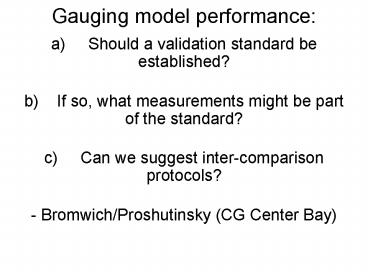Gauging model performance: PowerPoint PPT Presentation
1 / 7
Title: Gauging model performance:
1
Gauging model performance
- a) Should a validation standard be
established? - b) If so, what measurements might be part of
the standard? - c) Can we suggest inter-comparison
protocols? - - Bromwich/Proshutinsky (CG Center Bay)
2
1) Should a validation standard be
established?
- Yes, this is an important issue and has to be
based on (a) observational model quality and (b)
model errors. This is a specific task for
post-MIP studies. MIPs have to determine model
errors and then to recommend validation standards
(parameters, grids, spatial and temporal time
scales). - Observers and modelers have to be involved in the
establishment of these standards - Benchmarks have to be (a) integrative, (b) small
in number, (c) well constrained observationally
3
2. If so, what measurements might be part of the
standard?
- We have already discussed these parameters for
all disciplines yesterday and today (atmosphere,
ice, ocean, terrestrial, etc.) - Each discipline has to identify its most
important components, What are the major
integrated measures/processes which have to be
reproduced correctly (seasonal cycle, AO
variability, sea ice, etc.) for all disciplines.
4
2b. If so, what measurements might be part of the
standard?
- Atmosphere (how to reduce matrix of benchmarks?)
- 1. Large-scale integrative parameters/processes
- Mean state and variability patterns
- Storm track positions
- Precipitation (as an example of a crucial
parameter) - 2. Reproduce several important parameters and
processes - Validate annual energy balance at surface
(fluxes, clouds, stratification, interactions
with sea ice and ocean). - 3. To validate this use drifting stations, remote
technology. - 4. How to validate models against these
benchmarks? - 5. What are the observational errors?
5
Ocean
- Ocean and Ice
- Integrative processes sea ice drift, extent, and
seasonal cycle, distribution of sea ice
thickness - mean ocean parameters (vertical stratification
in the European and Canada basins), heat, salt
and mass transports through najor straits, Fram
Strait, Barents Sea Opening, Canadian Straits and
Bering Strait, - Fresh water surface layer, cold halocline, warm
Atlantic layer, deep cold waters - Correct fluxes via straits and shelf-basin
exchanges
6
Terrestrial
- Integrating parameters/processes
- Albedo
- Annual river runoff
- Soil temperatures/permafrost distribution
- Vegetation distribution should be linked to
dynamical vegetation model - 2. Individual processes/parameters
- Active layer depth variability
- Snow depth and density (snow water equivalent)
- 3. Data availability
- - Satellites for albedo, vegetation, snow
parameters - Representative station data snow, precipitation,
soil data - Processed gridded data (maps based on section
serveys)
7
Can we suggest inter-comparison protocols?
- Yes, a set of model intercomparison protocols
already exists in different MIPs. - For AOMIP we have a common grid, and a list of
integrated parameters to be inter-compared. Could
be based on expert estimates.

